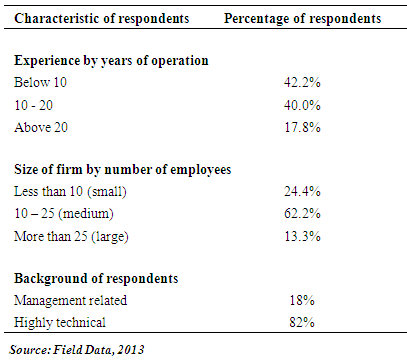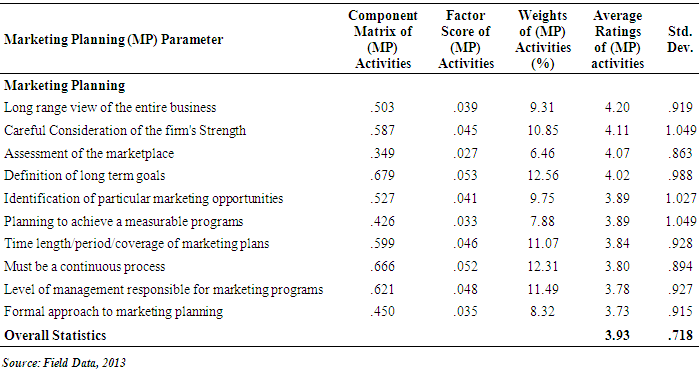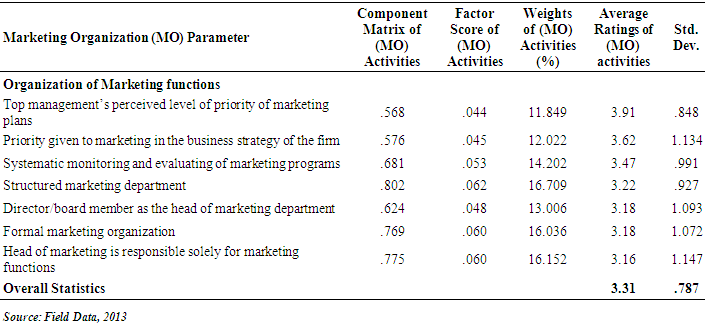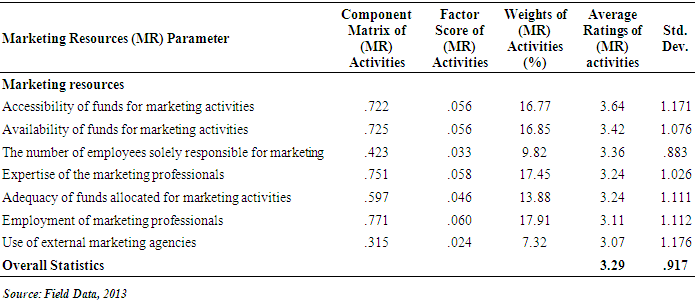-
Paper Information
- Paper Submission
-
Journal Information
- About This Journal
- Editorial Board
- Current Issue
- Archive
- Author Guidelines
- Contact Us
International Journal of Construction Engineering and Management
p-ISSN: 2326-1080 e-ISSN: 2326-1102
2015; 4(6): 230-237
doi:10.5923/j.ijcem.20150406.02

Marketing Performance of Quantity Surveying Consultancy Firms
Jonas E. Yankah
Department of Building Technology, School of Engineering, Cape Coast Polytechnic, Cape Coast, Ghana
Correspondence to: Jonas E. Yankah, Department of Building Technology, School of Engineering, Cape Coast Polytechnic, Cape Coast, Ghana.
| Email: |  |
Copyright © 2015 Scientific & Academic Publishing. All Rights Reserved.
This work is licensed under the Creative Commons Attribution International License (CC BY).
http://creativecommons.org/licenses/by/4.0/

The enormity of changes and the intensity of competition that are being experienced in the construction industry coupled with the quest for growth, profitability and survival of firms in such a fast changing highly competitive business environment have made the adoption and implementation of marketing in the management of construction business/enterprise indispensable. However, the ad hoc nature that characterizes the industry’s approach to marketing has resulted in an uphill struggle for effective marketing performance with little or no success. This paper is aimed at investigating the aspects of marketing function that can ensure desirable outcomes. The objectives were to examine the importance of marketing planning, organisation of marketing functions and marketing resources in the management of Quantity Surveying Consulting firms (QSCF) marketing programme in Ghana. After a thorough review of extant literature, a questionnaire survey of 48 QSCF which were reached through snowball sampling technique was undertaken to investigate the three dimensions. The survey results indicate that the firms are realising the importance of marketing in the management of a construction business with marketing planning being the most important function followed by organisation of marketing functions and marketing resources. It is however noted that recruiting marketing professionals is not considered as important activity by the firms. The need therefore exists for a better understanding of the ways by which marketing performance can be improved in the construction industry especially the consulting aspects of construction business.
Keywords: Marketing, Principal Component Analysis (PCA), Quantity Surveying, Ghana
Cite this paper: Jonas E. Yankah, Marketing Performance of Quantity Surveying Consultancy Firms, International Journal of Construction Engineering and Management , Vol. 4 No. 6, 2015, pp. 230-237. doi: 10.5923/j.ijcem.20150406.02.
Article Outline
1. Introduction
- The operating environment of construction consulting businesses is experiencing enormous changes which have given rise to intense competition. The situation is threatening the growth, profitability and survival of Quantity Surveying Consulting Firms (QSCF) that are operating in such business environment. However, marketing is identified as a tool for dealing with such situations. For instance, [6] noted that marketing is an activity with a potential for increasing sales. In line with this opinion, [1] described marketing as an ‘investment for creating a competitive edge and empowerment for competitive advantage’. Similarly, [19] pointed out that the most successful US firms were characterized by a common dedication to marketing. Surprisingly, the same cannot be said about marketing in relation to the construction industry especially the consulting aspects of the industry where quantity surveying firms are a major part.Several construction marketing researchers ([11]; [13]; [12]; [18]; [17]; [22]) have made observations that appear contrary to the role marketing has played in the operations of industries other than construction. As indicated by [11], marketing management has not yet been applied to any greater extent in the construction industry. In the same vein [13] also stated that marketing is less developed in the professional industry and often performed in most firms in an ad hoc basis. According to [12], marketing within the professional sector is considered at worst as an alien concept, and at best as a new development that is viewed with skepticism. Similarly, [18] observed that marketing has attracted only little attention among professionals, a situation which is in direct contrast to the role of marketing in the consumer goods industry [7], where marketing is accepted as one of the cornerstones of servicing the needs of clients and customers. Furthermore [17], indicated that some consulting firms are still struggling to understand and implement effective marketing programmes and this in the view of [22], suggests that QSCF are still clinging to an outdated, bull market philosophy: ‘As long as we do good work we will always have plenty of work’. This philosophy can be a factor that is preventing the (QSCF) from achieving sustainable growth in that lack of an effective marketing programme has the tendency to result in a mismatch of created offering by the firm and the needs of clients. These reports confirm the assertion by [23] that the construction industry has performed very poorly in marketing its services.Regarding the application of marketing in construction, very little research exists. Notable amongst such research relevant to this study are the works of [23], [1], [19] and [20]. The last three works focused on the application of the modified marketing mix theory applicable to construction without regard to other marketing functions that are considered as prerequisite (marketing planning, Organization of marketing functions and marketing resources) for the effective implementation of a marketing programme. In the work of [23], these functions were examined. However, of the range of firms in the built environment that were surveyed (Contractors, architectural service firms, civil engineering firms and structural engineering firms), QSCF were not considered.Again, an extensive search of leading electronic journal databases, including EBSCOHost, Emerald, Google Scholar and Science Direct suggest that little to nothing is known regarding the importance of these marketing functions (Marketing planning, Organization of marketing functions and Marketing resources) to the management of QSCF in general and Ghana in particular. This condition has resulted in the dearth of information regarding marketing function practices in QSCF.It is against this background, that this study was undertaken in an attempt to find the importance that is attached to marketing functions (QSCF) in Ghana. More specifically, this research has three objectives:1) To ascertain marketing planning activities undertaken by QSCF 2) To examine marketing organisation activities undertaken by QSCF 3) To ascertain marketing resources that are devoted to marketing function of QSCF The unit of analysis is Quantity Surveying Consultancy firms in Ghana that are self-employed in consultancy business rather than an individual Quantity Surveyor who is in a paid up employment. This article reports part of a larger study that was undertaken to investigate certain marketing elements that were measurable within QSCF, in an effort to assess the extent to which the marketing concept has been adopted and implemented. The rest of the article is structured as follows: First, a review of extant literature relevant to marketing performance practices or activities is undertaken. This is followed by a description of the research methods and procedures used in the study. The results of the enquiry are then discussed. Finally, implications, limitations and directions for future research are offered.
2. Literature Review
- Strategic Perspectives of Marketing Culture A structured marketing approach formulated in line with the organization’s aims and objectives provide the basis for successful marketing programme. A strategic approach to marketing entails marketing planning, organization of the marketing functions and allocation of resources before execution of the marketing activities. The assertion by [24] is that, knowledge about the way of carrying out marketing activities in a firm is necessary for assessing the extent to which marketing is implemented in a firm. Existence of marketing department, the number of people working in the department, status of the head of marketing in the organization and the existence of an independent sales department besides the marketing department are some of the criteria that are used for such assessment. Again, specific marketing activities such as marketing research, marketing planning, advertising, public relations, in-house marketing education and marketing intelligence also add to such criteria of assessment [3]. To classify these factors, [23] sorted out all the above and added more to those criteria and categorized them into three issues as follows: marketing planning, organization for marketing functions and marketing resources. Marketing PlanningAs noted by [23], the central objective of marketing planning is to ensure effective allocation of the firms’ resources to the marketing programme. This allocation must be in line with the marketing plan that has been formulated to achieve specific organizational aims. The allocation, in the view of [10], requires careful consideration of the firm’s strength, an assessment of the market place, definition of long-term goals, identification of particular marketing opportunities, and the implementation of measurable programs for exploiting these opportunities. Marketing planning is described as thinking systematically about the future and making current decisions on that basis [6]. Marketing planning, according to [6], is a continuous process because changes in construction industry and in general business environment are continuous. It has been stressed, therefore, that effective marketing begins with planning and proper planning begins with long-range view of the entire business [6]. It is noted by [23] that for every organization there should be a natural hierarchy of business activities that moves from an external focus through to internal action and control. This means that the extent of formal marketing planning has influence on the overall success of the marketing program. An outline of factors by [23] gives some important aspect of a marketing plan and argues that the absence of that will affect its success. The factors included the level of management where the responsibility for marketing programs lay and that was linked to the importance the firm attaches to it. The time ingredient which provides the marketing participants with a schedule for reaching various levels of accomplishment was also highlighted in that same outline.Organization of Marketing FunctionThe way marketing function is managed is crucial to its success. It has been argued by [23] that the degrees or level to which marketing is seen as a priority by top management, the marketing organization through structure, line of authority and responsibility, and the monitoring of marketing programs are key ingredients to the overall success of the marketing program.Marketing ResourcesAs stated by [2], the composition of marketing budget of many construction firms in the past were wages, sales expenses, product literature, and limited public-relations activities. In recent times, both professionals and practitioners have been seen to be engaged in other marketing activities that include professional activities designed to influence the market place, market research; cooperate identity programs and other marketing aids, such as the use of information services [23].Furthermore, [23] identified marketing resources and categorized them as manpower, skills and budget. The authors argue that, the resource in terms of manpower, skills and budget available for marketing activities must be adequate enough to accomplish its objective. A system where there exist adequate numbers of employees whose responsibilities are solely dedicated to marketing functions is highly recommended [23]. The employments of marketing professionals, comprising individuals who have professional qualification in marketing and the allocation of adequate funds from annual turnover to support annual expenditure of marketing were also highlighted as necessary ingredients for the overall success of the marketing programme [23].
3. Methodology
- This study is entrenched in the positivist philosophy which assumes that social phenomenon obeys natural laws and can therefore be subjected to quantitative logic [4]. By adopting positivism as the philosophy underpinning this study coupled with the deductive approach to scientific enquiry, the axiological, ontological and epistemological assumption underpinning the study dictated that the use of survey is the most appropriate option amongst the other quantitative data collection tools for the study [15]. This is illustrated in figure 1.
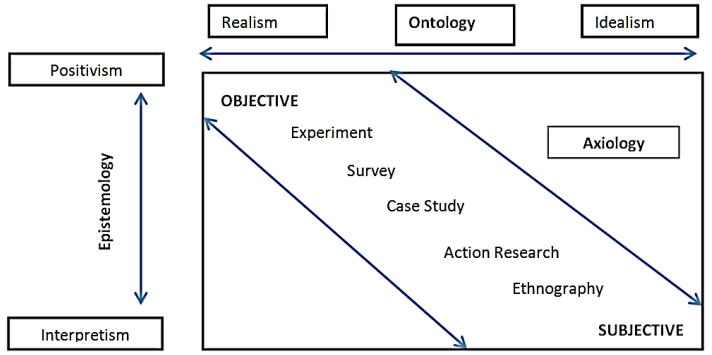 | Figure 1. Influence of research philosophy on choice of research instrument. Source: Adopted [15] |
 | (1) |
 | (2) |
4. Findings
- Of the 48 questionnaires administered, the researcher retrieved 45 fully completed questionnaires suitable for subsequent analysis. This high response rate of 93.75% is an indication of the industry’s interest in the subject area. Table 1 summarizes respondent characteristics based on experience of firm by years of operation, size of firm by number of employees and education background of respondents. A total of 42.2%were less than ten years old, and about 40.0% of them were 10 – 20 years old. Of the remainder, 17.8% have a history of over 20 years of existence. This indicates that a total of 82.2% of the firms are less than 20 years in existence. In terms of size, 24.4% can be considered as small size firm (i.e. having employees in the range of 1 – 10. Majority of the remaining firms are largely medium size (62.2%), and the large size firms stood at 17.8% (i.e. firms having employees of 10 – 25 and over 25.
|
4.1. Marketing Planning
- In order to understand what planning is done in the firms for the marketing programme, the question was asked: To what extent do the following factors affect the effective implementation of the marketing programme in your firm? Table 2 is a summary of the responses. The results are intended to shed light on the main planning activities that are done by the firm and what goes into the planning processes. The top two factors that are seen to be important are Long range view of the entire business and careful consideration of the firm's strength (see Table 2).
|
4.2. Organization of Marketing Functions
- This question was intended to elicit from respondents the way marketing is managed in terms of the organization of marketing functions in their firms. As to the Table 3 shows the responses to the question: To what extend do the following factors enhance effective organisation of marketing functions and activities in your firm?
|
4.3. Marketing Resources
- To understand what resources are necessary for effective implementation of a marketing programme the question was asked: To what extent do the following resources and related factors affect effective implementation of the marketing programme in your firm? The responses are summarized in table 4 below.
|
5. Discussions
- The common theme running through the available construction marketing literature is that the construction industry has performed poorly in marketing its services and products. The marketing performance of firms in the built environment especially the consulting industry has come under serious criticism. Within the consulting industry, marketing is at best performed in an ad hoc manner and at worst not performed at all.This study has examined the marketing management functions that are considered as necessary prerequisites towards a successful marketing management program. The study examined these functions in the built environment consulting industry where marketing is viewed as inappropriate or not applicable. This study contributes to construction marketing literature by demonstrating the importance of marketing functions relevant for the successful adoption and implementation of a firms’ marketing programme.
5.1. Summary of Findings
- The study has shown that marketing planning is of paramount importance (mean score =3.93, Table 2) to the QSCF and that is very encouraging in that effective marketing begins with planning [6]. Organization of marketing functions follows next before marketing resources in that order of descending importance (mean score = 3.31 and 3.29, Table 3 and Table 4 respectively). Majority of the firms (82%) have technical persons responsible for marketing in addition to their core functions. In an industry where production is more important than management [16], more attention is paid to the technical/core functions leaving the organization of the marketing functions to suffer is expected. Also, about 86.6% of the firms fall within small to medium size and at the same time 82.2% of the firms are still at their infant stages of business development (less than 20 years in operation) as shown in Table 1. These circumstances can limit the firm’s resources in terms of manpower, skills and budget for marketing management functions. This has led to the non-recruitment of marketing professionals in the firms even though they admit that marketing professional are necessary for the success of a marketing programme.The resource constraints of these firms compel them to focus more on production efficiency than marketing aspects. This also explains the reason why majority (82%) of those responsible for marketing activities is technical persons who manage marketing functions in addition to their core functions. The firms are not able to employ marketing professional due to limited budget and the skill of those in charge of marketing activities is low due to the nature of education and training of the Quantity Surveyors. These circumstances confronting the QSCF can be blamed on the ad hoc manner in which marketing management issues are approached in the QSCF.Again, the firms do not accept it as necessary where the head of marketing is solely responsible for marketing functions apparently, because the norm in the industry is that the marketing function is added to the responsibilities of an employee to manage it in addition to his own core responsibilities as a technical person in the firm. The priority given to marketing in the firms’ business strategy and the priority given to it by top management were also ranked as key elements in the organisation of marketing functions QSCF.
5.2. Managerial Implications
- This study indicates that, successful execution of marketing activities depends to a large extent on marketing planning, organisation of marketing functions and the availability and accessibility of the required resources. This call for employment of marketing professionals (individuals with professional training in marketing) to manage a marketing department set up with adequate professional staff depending on the size of firm and the range of business activities that the firm engages in. The marketing department should be headed solely by the marketing professional. The marketing department must allocate adequate funds to carry out its operations.Whilst dealing with the above issues, management must also work to achieve the following; v training of all customer contact staff in the fundamental advocacy of marketing in satisfying customer needs;v recognizing the need for an integrated marketing approach using grounded market intelligence on which optimal decisions should be based;v demonstration of consolidated commitment to marketing by top management and partners;v active involvement at all hierarchical levels in the formulation of marketing plans so that successful implementation can be enhanced.Achievement of these could mark the beginning of successful marketing performance of the firm.
5.3. Limitations and Directions for Future Research
- Although the sample size was deemed acceptable, a larger sample could have allowed for more powerful analysis. The sample constraint did not allow for measurement of non-response bias. Again, an extremely large percent of the sample (82.2%) were within the bracket of small to medium size enterprises (SME’s).As a result, the findings could be more applicable to SME’s than large firms.Future research should focus on large firms to test the validity of the results of this study on larger firms in Ghana as well as other geographical regions. It is also important that there should be a further research work on this subject to examine the effect of other demographic factors based on contract type, annual revenues and success in getting new contract award on the marketing functions of such firms.
 Abstract
Abstract Reference
Reference Full-Text PDF
Full-Text PDF Full-text HTML
Full-text HTML